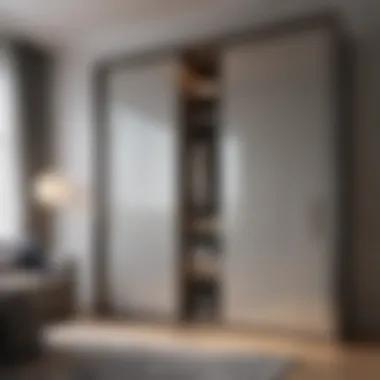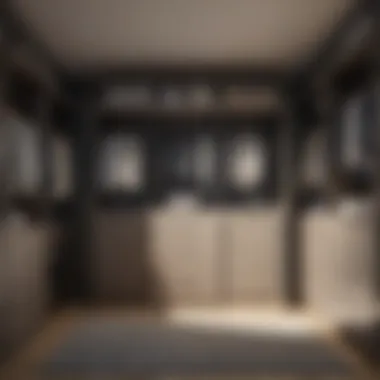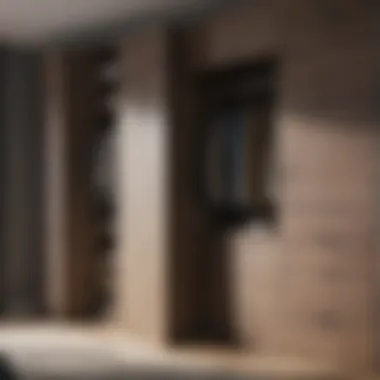Wardrobes for Bedrooms: A Detailed Overview


Intro
When it comes to the careful orchestration of bedroom spaces, wardrobes often emerge as central figures in both aesthetics and functionality. A well-chosen wardrobe can redefine a bedroom, transforming cluttered chaos into organized harmony. This guide will not only explore varied styles and materials available for wardrobes but also outline how to choose one tailored to individual needs and room specifics, ultimately improving both usability and visual appeal.
Wardrobes play an encapsulating role in the bedroom experience; they aren’t just storage solutions, but vital elements that influence the overall design of a space. From contemporary minimalist approaches to the ornate features of traditional craftsmanship, there’s a vast universe of options that serve various tastes and preferences.
Materials:
Planning is the cornerstone of any successful bedroom wardrobe project. Before diving into the construction world, assemble your materials. Below is a detailed list of essential items, along with suggested measurements to ensure a snug fit.
- Plywood Board:
- Wood Screws:
- Hinges:
- Drawer Slides:
- Handles:
- Wood Finish or Paint:
- Sandpaper:
- Dimensions: ¾ inch thickness x width as per design x height as per design
- Length: 1.5 inches (for securing boards together)
- Type: Cabinet hinges, usually two or three needed depending on door size
- Length: 16 inches (for in-line drawers)
- Number: Based on the number of drawers and doors
- Quantity: Sufficient for two coats (check can specifications for coverage area)
- Grit: 80 and 220 (for smoothing edges)
Once your materials are collected, you’ll be able to visualize the transformation from a simple design to a fully functional wardrobe.
DIY Steps:
In this section, we will discuss the detailed instructions for constructing your wardrobe. Taking each step methodically ensures that your project remains on track and free of significant hiccups.
- Planning the Design: Before taking any action, sketch your desired wardrobe layout, including measurements. Think about space—how much do you have and how do you want to utilize it?
- Cutting the Plywood: Using a circular saw, cut the plywood according to your design. Pay attention to measurement precision to avoid wasting material.
- Assembling the Frame: Start by constructing the base frame. Use wood screws to secure the corners. Ensure everything is level.
- Fitting the Back Panel: Attach the back panel using screws. This provides stability and prevents wobbling.
- Hanging the Doors: Install the cabinet hinges on the door edges and attach them to the frame. Ensure smooth movement before securing tight.
- Install Drawers: Slide in the drawer slides, ensuring they're leveled. Place the drawers and check for any friction or imbalance.
- Finishing Touches: Sand the edges with both coarse and fine grit sandpaper to achieve a smooth finish. Apply wood finish or paint for aesthetic appeal.
- Adding Handles: Position and secure the handles for effortless opening.
Technical Aspects:
Understanding the tools and timing specifics is paramount as these elements can greatly elevate the quality of your project. Here is what you’ll need:
- Tools Required:
- Timing:
- Techniques for Quality:
- Circular Saw
- Drill
- Screwdriver
- Level
- Measuring Tape
- Preparation: 1-2 hours for planning and material gathering
- Construction: Approx. 6-8 hours depending on the complexity of design
- Always pre-drill holes to prevent wood from splitting
- Use a level frequently to maintain straight edges during assembly
DIY Project Process:
Following these sequential steps will ensure a smooth construction process:
- Measure and mark all cuts on your plywood before using the saw.
- Always keep safety gear on (goggles, gloves) while operating saws.
- After assembling, check that every joint is tight.
- Allow at least a full day for the finish to cure before moving the wardrobe into place.
Troubleshooting Tips:
Each DIY project can come with its share of difficulties. Here are some common mistakes alongside solutions:
"Plan carefully. Because sometimes, the devil lies in the details."
- Problem: Doors do not align properly.
- Problem: Drawers stick or do not glide smoothly.
- Solution: Adjust hinges until the door aligns correctly.
- Solution: Check that slides are level and not obstructed.
By following this guide, readers can approach their wardrobe projects with confidence, empowered with the knowledge and skills necessary for successful execution.
The Role of Wardrobes in Bedroom Design
Wardrobes serve as more than just storage solutions in bedroom design; they are pivotal to how space is utilized and how the overall aesthetic is perceived. Understanding the importance of wardrobes enables homeowners to make informed decisions that blend functionality with style. By exploring the myriad benefits and considerations, one can grasp how wardrobes can transform bedrooms into harmonious retreats.
Functionality and Storage Solutions
The day-to-day functioning of wardrobes goes beyond mere clothing storage. They have the potential to maximize available space, optimize organization, and even simplify daily routines.
Maximizing vertical space
Utilizing vertical space in wardrobe design means going beyond the basic, linear setups. Tall wardrobes allow homes to take advantage of higher ceilings, offering additional storage without occupying breaching floor space. This maximization is particularly crucial in urban living situations, where every square inch matters. By incorporating shelves or hanging rods that stretch up, users can store seasonal clothes or items not frequently needed. In smaller bedrooms, achieving this verticality is a popular choice, as it keeps the room from feeling cramped.
Advantages include:
- Efficient use of height: Plenty of room for storage while maintaining floor clarity.
- Enhanced organization: Offers diverse options for categorizing items from the bottom up.
However, one must also be cautious. Excessively high storage can make retrieval difficult for shorter individuals, necessitating a step stool in some scenarios.
Built-in versus standalone wardrobes
When weighing the option between built-in and standalone wardrobes, it often comes down to personal preference and space planning. Built-in wardrobes offer a streamlined appearance, crafted to fit seamlessly into the design of the room. This leads to more effective utilization of corners and nooks, especially in oddly shaped rooms. On the flip side, standalone wardrobes present versatility. They are easily movable and can be swapped with different styles depending on trends or personal taste.
Unique features include:
- Built-in: Customizable shelves, materials, and designs.
- Standalone: Easily rearranged when redecorating.
Both types come with their own advantages. However, it's worth noting that built-ins typically require a larger initial investment, while standalone options can offer budget-friendly choices.
Considerations for small bedrooms
In compact living spaces, the considerations for wardrobe selection should be particularly careful. The aim is to blend function and style without cluttering the bedroom. Opting for multi-functional furniture can prove a wise idea. Many modern wardrobes offer internal compartments for shoes, accessories, and folded items which maximize the benefits of limited floor space.
Key characteristics include:
- Clarity in layout: Streamlined structures that imply a sense of openness.
- Creative solutions: Innovative designs that may include mirrors or sliding doors; these lend an perception of depth in cramped environments.


When considering small bedrooms, it’s important to turn a potential disadvantage into an advantage by embracing creativity and maximizing the space creatively.
Aesthetic Contributions
Wardrobes also contribute significantly to the bedroom's aesthetic appeal. Their presence can complement a peaceful environment or stand boldly as a statement piece.
Color and finish options
The impact of color and finish options can’t be overstated. These choices can set the mood of the room. Lighter finishes can make space feel airy, while darker tones can add richness and depth. Moreover, the material finish—from matte to gloss—also influences how textures play and interact with surrounding decor.
Unique features are:
- Customization: Homeowners can select colors that tie into the existing palette or choose contrasting shades for a pop.
- Finish variation: Different effects can completely shift the room's ambiance.
However, careful selection is advised. Not all finishes are equally easy to maintain, and what looks great may not always be practical in terms of durability.
Blending with bedroom decor
Wardrobes should harmonize with the bedroom aesthetic, ensuring a cohesive design. If the decor leans toward minimalism, a sleek wardrobe can enhance that simplicity. Alternatively, if a more eclectic style is favored, a bold, vintage piece could serve as a delightful focal point.
The key characteristic here is:
- Balance: Ensures the wardrobe complements rather than competes with other elements in the room.
However, blending requires a discerning eye; not every wardrobe will fit. A misjudged choice may disrupt the visual flow.
Creating focal points
Placing a wardrobe can serve as a design focal point. A beautifully designed wardrobe can draw attention and set the tone for the bedroom. Unique designs or elaborate hardware can serve as conversational pieces that lend personality to the space.
When considering this, the feature of:
- Statement pieces: Wardrobes that might feature unique carvings, bold colors, or unusual shapes.
However, it's crucial to balance the focus. An overly dominant wardrobe can overwhelm a small bedroom and alter the intended ambiance negatively.
"Wardrobes are more than storage; they’re essential to the bedroom's character and function."
Types of Wardrobes: An Overview
Wardrobes serve as one of the foremost functional and aesthetic elements within a bedroom. Understanding different types of wardrobes is crucial for choosing the right fit that aligns with your space and personal style. Here, we examine various wardrobe types, evaluating their distinct characteristics, advantages, and practical considerations.
Sliding Door Wardrobes
Space efficiency
Sliding door wardrobes stand out primarily because of their space-saving design. They lack traditional swinging doors, making them perfect for compact areas where getting too close to the wardrobe could pose a challenge. This feature allows for seamless integration in small rooms or tight corners. It’s a lifesaver for bedrooms where every square foot counts, as users can glide open the doors without worrying about clearance.
One unique aspect of sliding doors is that they can often accommodate built-in storage systems without eating up precious room that traditional doors might require. However, installation can sometimes be tricky, necessitating precise measurements to ensure a smooth sliding mechanism.
Design versatility
When it comes to design versatility, sliding door wardrobes shine. They come in an array of configurations, including mirrored panels, wood finishes, or modern glass designs. This means they can effortlessly complement various décor styles, from sleek and minimalistic to warm and traditional.
Moreover, the vast selection enables homeowners to customize their wardrobes to fit not just their storage needs, but also their personal aesthetic. This adaptability is a major reason why many people lean toward sliding door wardrobes as a popular choice.
Glass options and their implications
Choosing glass panels for sliding wardrobes brings a modern twist and a touch of elegance. Glass options, such as frosted or tinted glass, can visually expand a room, making it feel breezy and open. This can be particularly beneficial in smaller spaces. However, one must consider the implications of maintenance, as glass can require more frequent cleaning to keep it looking pristine.
In addition, glass can create a sense of openness, allowing you to showcase your wardrobe’s interior decor and organization. However, this may not be ideal if you prefer the intimacy of a closed, concealed storage option, as it can also expose your belongings to view, potentially creating a visual clutter.
Hinged Door Wardrobes
Accessibility considerations
The hinged door wardrobe is favored for its straightforward accessibility. Unlike sliding doors, hinged wardrobes open outward, making it easy to view the whole contents at once. This is especially helpful for individuals who might have difficulty reaching into deeper corners of a sliding wardrobe.
Moreover, these doors typically allow for more intricate interior storage options, such as built-in hooks and compartments that enhance organization. However, depending on the space, they can take up more room when opened, restricting the use of adjacent areas when accessed.
Traditional appeal
In terms of traditional appeal, hinged door wardrobes often embody classic craftsmanship and solid construction. They can be highly decorative, often featuring ornate carvings and sophisticated finishes. This traditional aesthetic adds a sense of permanence and style that many homeowners desire.
With their reliability and robust nature, hinged wardrobes might be more enticing for those who value quality wood as opposed to contemporary materials.
Customization options
Another aspect where hinged wardrobes excel is customization options. Homeowners can choose from a myriad of designs, wood types, colors, and hardware. The flexibility in design allows for a high level of personalization which many find vital when creating cohesive bedroom designs.
However, extensive customization can lead to higher costs and longer lead times for delivery. Understanding your budget and timing needs is essential to weigh the benefits against potential downsides.
Corner Wardrobes
Utilizing awkward spaces
Corner wardrobes are perfect for utilizing awkward spaces in a room. They fit snugly into the corners of a bedroom, transforming what might otherwise be wasted space into functional storage. This can be particularly advantageous in smaller rooms where maximizing space is crucial.
Taking advantage of corners allows for more creative room layouts, giving you the freedom to place furniture more optimally around the room. Nonetheless, while they maximize utility, the unique shapes can sometimes make access to the rear areas trickier depending on how deep the wardrobe is.
Design approaches
The design approaches for corner wardrobes can be varied, ranging from L-shaped to pentagonal. This allows for a stylized look that can match the bedroom theme, whether it be contemporary or rustic. The design flexibility enhances the visual flow in a space, adding interest and functionality at the same time.
However, buyers should be mindful that unique designs may complicate installation and could lead to higher costs and potentially more challenging maintenance.
Storage capabilities
When it comes to storage capabilities, corner wardrobes can surprise you with their capacity to hold a considerable number of items in a compact area. Many models feature shelves, hanging rods, and drawer units that optimize space effectively, especially in rooms that require more vertical storage solutions.
Despite their high storage potential, homeowners must consider how deep or shallow their corner wardrobe is. Deeper models need careful planning on how to access the back rows, which can be an occasional inconvenience for those looking for simplicity in everyday use.


Materials Used in Wardrobe Construction
Wardrobes are essential fixtures in any bedroom, and the materials they are made from play a significant role in their functionality, durability, and aesthetic appeal. Selecting the right materials can affect not only the wardrobe's longevity but also its maintenance needs and overall environmental impact. Here’s a closer look at some popular materials used in wardrobe construction and their many nuances.
Wooden Wardrobes
Types of wood and their properties
Wooden wardrobes have an allure that often feels timeless. Different types of wood, such as oak, pine, or walnut, each carry unique properties. For instance, oak is renowned for its strength and natural beauty, making it a top choice for high-quality wardrobes. It's dense and resistant to wear, ideal if you're looking for something that stands the test of time. Pine, on the other hand, is lighter and more affordable, yet also softer, which means it might not be the best companion for heavy-duty use.
Moreover, using wood also allows for a variety of finishes—from glossy varnishes to matte stains—that can dramatically change the wardrobe's appearance. It's crucial to consider what look you want to achieve. In this article, we especially emphasize oak for its robustness and walnut for its rich color depth, both of which can enhance the character of your bedroom.
Finishes and maintenance
The beauty of wooden wardrobes often lies in their finishes. A well-applied finish can enhance the wood grain while protecting it from scratches and stains. Oil-based finishes are popular because they penetrate the wood, maintaining a natural look while providing a solid barrier against wear. However, they can require more maintenance over time compared to polyurethanes, which form a surface layer that’s easier to clean.
Maintaining a wooden wardrobe requires regular dusting, and an occasional wipe-down with a damp cloth. This isn’t a one-off chore; it’s a commitment. A wardrobe that’s left to gather dust won’t just look worse; it can also suffer from long-term damage. Many homeowners find themselves needing a refresher after a few years to keep their wardrobes looking sharp and new.
Environmental considerations
With the growing focus on sustainability, it’s vital to think about where your wood comes from. Opting for reclaimed wood or sustainably sourced timber is not just beneficial for the planet; it also adds a story behind your furniture. The carbon footprint associated with transporting and processing wood can be significant, thus choosing locally sourced options can lessen your impact.
Also, some finishes and treatments can release harmful compounds into the air. Choosing non-toxic or environmentally-friendly finishes can reduce health risks while maintaining a wardrobe’s beauty. Making these selections contributes positively to your living space, aligning with broader environmental values.
Metal Wardrobes
Durability and security
Metal wardrobes are becoming increasingly popular, especially in contemporary spaces. They are often constructed from steel or aluminum, which provides not just a sleek, modern look but also exceptional durability. This durability means that metal wardrobes are often fire-resistant, a compelling feature if safety is a priority.
In terms of security, these wardrobes can often be easily fitted with locks or more advanced locking mechanisms. This is especially appealing for those storing valuable items, as the sturdy material offers peace of mind. However, if you live in a humid area, it’s important to consider that metal can rust, so proper ventilation and treatment are necessary to keep your wardrobe looking its best.
Modern designs and applications
The design diversity offered by metal wardrobes is noteworthy. They come in a variety of colors and styles, bending the traditional ideas of bedroom furniture. From minimalist designs to sleek, industrial looks, metal wardrobes can suit many styles. Consider the aesthetic implications of selecting a metal wardrobe; it can shift the entire vibe of a space to be more contemporary.
Furthermore, metal wardrobes can be easily combined with wood or glass, making them versatile in mixed-material designs. This allows homeowners to create custom solutions that fit their personal preferences and the unique layout of their bedrooms.
Weight considerations
It's worth noting that while metal wardrobes are durable, they also tend to be heavier than their wooden counterparts, which may influence your choice depending on the floor strength and layout of your room. If you’ve got a delicate wooden floor, consider whether you want to risk placing a heavy wardrobe on it. That said, their sturdiness can make them less prone to tipping, offering stability in active households.
MDF and Particleboard
Cost-effectiveness
For those who are budget-conscious, both MDF (Medium-Density Fiberboard) and particleboard are attractive choices. They are generally less expensive than solid wood options and still provide decent functionality. The affordability makes them a practical solution for families needing ample storage that won't break the bank.
However, it’s essential to remember that while they offer an economical option, these materials may not have the longevity of solid wood. If you’re looking for a wardrobe that will withstand years of use, you might need to factor in possible replacements in your planning.
Design options
One of the substantial advantages of MDF and particleboard is their design versatility. They can be easily shaped and finished, allowing for an extensive range of styles and colors. This means if you find yourself drawn to specific aesthetics—like a sleek, modern edge or a colorful pop—these materials can likely cater to your desires.
Yet, these materials do have limits with heavy loads. If you plan on housing numerous heavy winter coats and shoes, think twice as they might sag over time. It’s essential to consider the balance between design aspirations and practical usage.
Sustainability aspects
When it comes to environmental impact, MDF and particleboard can have mixed reviews. While they often utilize wood scraps and by-products, leading to efficient use of materials, the adhesives used in their construction can emit formaldehyde. Selecting brands that prioritize low-emission adhesives can mitigate some risks, allowing you to make a more eco-friendly choice.
This discussion puts a spotlight on the importance of considering materials in wardrobe construction, as they play a defining role in functionality, aesthetics, and sustainability. Selecting the right material aligns not just with personal taste, but also with practical considerations for long-term use.
Selecting the Right Wardrobe for Your Space
Selecting the right wardrobe is more than just a practical choice; it’s about finding the perfect match for your lifestyle and aesthetic. A well-considered wardrobe can transform a cluttered bedroom into an oasis of calm, offering both style and functionality. Understanding the unique elements involved in this selection can ensure that your choice complements the overall design while catering to your specific needs.
Assessing Available Space
Measuring dimensions
Measuring dimensions is a critical first step in making your wardrobe choice. Accurately gauging the area where the wardrobe will reside is imperative to avoid mismatches later on. This ensures that the wardrobe fits well, allowing for easy movement and access. An often-overlooked characteristic is the vertical height of the room. Higher ceilings may allow for taller wardrobes or even specialized units that utilize space effectively.
A unique feature of measuring dimensions is that it varies from room to room. Some bedrooms have niche spaces or odd corners that can be utilized, while others may have conventional layouts. Knowing precise measurements helps in choosing the right wardrobe type��—be it corner, hinged, or sliding doors—thus preventing any unwanted surprises during installation.
Floor plans and layout
When considering floor plans and layout, it's essential to visualize how the wardrobe integrates with other furniture pieces. This consideration contributes significantly to an aesthetically pleasing environment. Key characteristics include zoning the room properly, ensuring that each area serves its purpose without overcrowding the space.
A unique aspect of understanding floor plans is being able to see where the wardrobe’s position can enhance or detract from room flow. A wardrobe strategically placed can provide a designated nook for dressing while maintaining a line of sight across the room. Disadvantages may arise if the wardrobe blocks significant pathways or windows, hence the layout becomes crucial.
Visualizing wardrobe placement
Visualizing wardrobe placement is more than just a thought exercise; it's about creating a mental image of how things will be after the wardrobe is installed. This contributes to the goal of achieving an organized and stylish bedroom. The key characteristic here lies in envisioning how the wardrobe complements other furnishings and the room's overall color scheme and ambiance.
A unique feature of this process involves sketching or digitally rendering the room with the wardrobe in its proposed position. This can highlight potential issues before the purchase. While it might seem tedious, taking the extra step can prevent costly mistakes. The disadvantage could be overthinking to the point of confusion, but if approached methodically, it leads to a more satisfying result.
Identifying Personal Needs
Amount and type of clothing
The amount and type of clothing one possesses directly impact wardrobe selection. Knowing whether your wardrobe should house business attire, casual wear, or an assortment of both is essential. This aspect plays a significant part in determining shelving, hanging space, and drawer configurations. Tailoring your choices to fit the specifics of your wardrobe contents ensures a harmonious storage situation.
One unique feature of identifying clothing types is that it guides the selection of interior components, such as adjustable shelves for seasonal collections or dedicated pant hangers for trousers. While a large wardrobe may offer ample space, it could lead to inefficient organization if the clothing types are not considered well.
Additional storage requirements
Sometimes, it's not just clothing that needs a home. Identifying additional storage requirements enables one to plan for items like linens, shoes, or accessories. This consideration is vital as it affects wardrobe depth, width, and internal layout. Keeping these additional needs in mind enables you to choose a wardrobe that maximizes utility.
A unique aspect is the layering of storage solutions. For instance, including pull-out bins for shoes or specialized compartments for jewelry can significantly enhance the functionality of the wardrobe space. However, overloading the wardrobe with too many sections can lead to overcrowding, which complicates access to your belongings.
Preference for organization systems


Your preference for organization systems is another major factor in wardrobe selection. Some individuals thrive on highly-structured setups, while others may prefer a more casual approach. Understanding your inclination towards organization helps in selecting what kind of compartments or dividers to include, leading to a customized experience.
The key characteristic of having a solid organization system in place is that it can simplify your daily routine, making it easier to find items quickly. Unique features could include adjustable shelves or special compartments tailored to specific clothing styles. The disadvantage could come from committing to a rigid organization style, which might not adapt well with changing wardrobe needs over time.
Selecting the right wardrobe for your space goes beyond mere aesthetics; it’s about creating a functional environment tailored to your needs.
Wardrobe Organization Techniques
Keeping a wardrobe organized isn't just about aesthetics; it can significantly improve daily routines and lifestyle. Efficient wardrobe organization systems maximize available space, enhance accessibility, and create a serene personal retreat. Proper techniques ensure that every item has its designated space, which not only simplifies finding what you need but also streamlines daily dressing rituals. With an organized wardrobe, you can say good riddance to the frustration of searching for your favorite pair of shoes or that elusive top among the chaos.
Maximizing Drawer and Shelf Space
Folding vs. hanging garments
When it comes to organizing a wardrobe, the debate over folding versus hanging garments often surfaces. Folding, while straightforward, often shines in creating organized stacks of clothing, especially for items like sweaters or jeans. It prevents unwanted stretching and keeps everything visibly accessible. Notably, many prefer this method as it maintains garment integrity while saving precious hanging space for dresses and coats. However, a disadvantage is that folded clothes can become disorganized if not carefully maintained, leading to stacks that topple over.
On the other hand, hanging garments keeps them wrinkle-free and easy to see. This technique is popular for items like blouses or skirts that benefit from hanging, ensuring they are easily available without the need to dig through piles. Yet, it can be less space-efficient; many find that hanging too many items can lead to overcrowding. Each choice carries weight depending on the type of clothing and the individual's preferences.
Using drawer dividers
Drawer dividers serve as a simple yet effective solution to keep items within drawers from morphing into a disorganized mess. They create distinct sections for various clothing categories, making it easier to locate undergarments, socks, or accessories without rifling through disarray. Their key feature lies in their versatility; they can be adjusted or even customized to suit specific needs, enhancing the drawer's utility.
The charm of drawer dividers lies not only in organization but also in how they streamline routine tasks. However, they do require a bit of initial effort to set up correctly. Some enthusiasts may find that not every drawer necessitates dividers, leading to a potential over-organization, which can become cumbersome when adjusting the system later.
Seasonal storage strategies
An effective wardrobe organizes the current season's essentials while setting aside out-of-season items, which is where seasonal storage strategies come into play. This method allows for greater visibility of readily worn garments and helps to keep clutter to a minimum.
A key characteristic of seasonal storage is the opportunity to declutter regularly—not only making space but also prompting an assessment of items no longer needed. This practice fosters a sense of clarity and may even lead to rediscovering forgotten treasures. However, a downside is that it calls for a bit of diligence each season; neglecting this strategy can result in overflow from the past seasons cluttering the space, ultimately creating stress.
Implementing Smart Storage Solutions
Add-ons and accessories
Add-ons and accessories can make a world of difference in evolving an ordinary wardrobe into a functional powerhouse. These enhancements, such as hanging organizers, additional rods, or custom shelves, can optimize every inch of space. One of their most notable advantages is the flexibility they bring, allowing personalization tailored to unique needs.
However, integrating these can sometimes lead to confusion if they aren't intuitively placed, resulting in an initial learning curve. Users often navigate the balance between additional utility versus overwhelming the space with too many devices, leading to a cluttered appearance.
Vertical storage ideas
Taking advantage of vertical space can transform a wardrobe that feels cramped into a utility dream. For instance, adding shelves above hanging garments can hold shoes or decorative boxes, effectively utilizing high spaces that often get neglected. These solutions emphasize a key strategy of maximizing room, tapping into often overlooked areas.
Yet, there’s always the consideration of accessibility; taller shelves may require a step stool. A thoughtfully curated arrangement ensures ease of use while enhancing the overall functionality of the wardrobe.
Using bins and baskets effectively
Utilizing bins and baskets can effectively handle the chaos in a wardrobe. Their adaptability allows for a neat solution for items lacking a dedicated space, such as scarves, belts, or seasonal accessories. Bins maintain a unified look, minimizing visual clutter while providing a swift, practical way to store away belongings.
The unique feature of using bins lies in their portability—being able to pull out a bin when needed can save time. However, users need to remain vigilant with labeling. A basket without a proper label can lead to confusion, and rummaging through mixed contents can ruin the charm of an organized setting.
By implementing these strategies and tips, you can morph a simple wardrobe into an oasis of order and efficiency, paving the way for a smoother start to your day, every day.
Maintaining Your Wardrobe
Maintaining a wardrobe is about more than simply ensuring it looks good. It is a crucial component of enhancing the longevity of the furniture, ensuring that it serves its purpose effectively, and keeping your space organized. Regardless of the material or style of the wardrobe you choose, some consistent practices in care and upkeep can yield significant benefits. Not only does a well-maintained wardrobe contribute to the aesthetic appeal of your bedroom, but it can also enhance your overall experience when using the space.
Cleaning and Care Recommendations
Wood cleaning techniques
Keeping wooden wardrobes in top shape requires specialized attention. Wood is a living material that can be influenced by environmental factors like humidity and temperature. Regular dusting is a must to avoid dirt buildup that can scratch surfaces over time. Gentle cleaning solutions, such as a mix of mild soap with water, are often recommended. Using a soft, lint-free cloth to apply the solution helps maintain the finish of the wood.
Key characteristic: Its natural resistance to wear makes wood cleaning a popular choice.
What sets wooden wardrobes apart is their capacity to age gracefully. However, improper cleaning techniques can lead to damage or unsightly marks, emphasizing the favorability of careful and considered cleaning practices. The uniqueness of the wood's grain adds character, but neglect can dull its shine, making consistent cleaning worthwhile.
Regular maintenance checks
Conducting regular maintenance checks for your wardrobe overall is essential. Even a well-crafted piece can develop issues over time. Checking hinges, door alignment, and any possible wear on handles can save you from larger headaches later on. Keeping an eye out for these issues early on makes restoration easier, should the need arise.
Key characteristic: Proactive maintenance is undeniably effective.
This approach allows you to keep your wardrobe functioning smoothly. Think of it as a health check-up for your furniture. A small effort can have long-lasting benefits, preventing costly repairs or replacements. While maintenance can feel like a chore, this aspect forms the backbone of keeping your wardrobe in functional order.
Addressing wear and tear
Every wardrobe, no matter how sturdy, will experience some degree of wear and tear. This can manifest as chipped paint, scratched surfaces, or even loosened joints. The critical factor is addressing these problems promptly. Applying touch-up paint or varnish as needed can restore the wardrobe’s visual appeal while also shielding the wood from future damage.
Key characteristic: Attention to detail pays off.
When tackle these concerns early, it can save a lot of hassle in the long run. Applying proper fixes when they arise enables the wardrobe to maintain its functional integrity as well as its overall beauty, resulting in a piece that remains a cherished part of your bedroom for years to come.
Seasonal Updates
Changing seasons can warrant updates in your wardrobe’s organization and contents. This practice not only adds a fresh feel to your space but also enhances the efficiency of your storage. Transitioning clothing and accessories according to the time of year can simplify your daily routine.
Swapping out seasonal clothing
One effective way to keep your wardrobe organized is by swapping out seasonal clothing. During changes in season, it makes sense to rotate your wardrobe’s contents to suit current weather conditions. This strategy prevents overcrowding and ensures easy access to the clothing you need, when you need it.
Key characteristic: Efficient seasonal swaps keep your wardrobe clean and functional.
The unique feature here is that it allows for annual inventory, clearing space for new items. Discarding anything no longer suitable for the season maintains a decluttered present and allows you to evaluate your needs as they change.
Assessing for donations and discards
In the spirit of refreshing your wardrobe, it’s beneficial to assess items for donations or discards. This practice not only helps keep clutter at bay but also lends a helping hand to those in need. A closet that is orderly allows for better visibility of what you do own.
Key characteristic: Giving your clothes a second life is rewarding.
The unique downside here, though, is the emotional attachment we sometimes have to clothing. Remember that parting with certain items can lead to a more functional and enjoyable wardrobe.
Reorganizing for changing needs
Reorganizing your wardrobe allows you to adapt to changing needs. As lifestyle or work demands shift, the way you utilize your storage should correspondingly evolve. Reconfiguring shelves, adding organizers, or simply arranging clothes by type or frequency of use can create a storage solution that feels custom-tailored to you.
Key characteristic: Flexibility in storage solutions highlights continuous improvement.
This unique aspect makes your wardobe not just a storage unit, but a true reflection of your current life stage. As life progresses, so should your organization methods, ensuring that every piece has its place, making it easier to access and appreciate your belongings.







